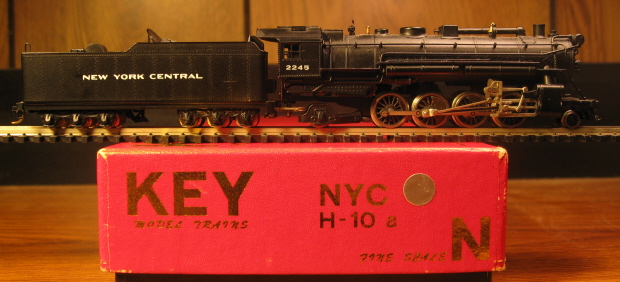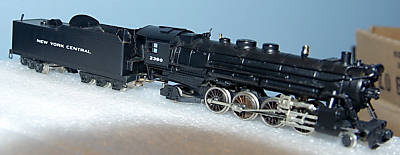

Introduced: 1983
Key released these NYC H-10 Mikados (H-10A and H-10B) at the same time. As far as I know, there was just the one production run.

The chassis is all-metal and fairly minimalistic (with most of the heft being provided by the locomotive shell). The motor is an open-sided 5-poler. The second set of drivers (from the front) are equipped with traction tires. Right-rail pickup is provided by the right-side drivers (excepting the TT-equipped one, obviously). Left-rail pickup is provided by all six left-side tender wheels (with current transferred to the motor via a stiff wire on the drawbar). All the rest of the wheels are electrically neutral. Two pairs of drivers are geared (the other two pairs are turned solely by the cranks). All gearing is metal. Wheel flanges are low-profile and suitable for operations on Code-55 track. A dummy knuckle coupler is mounted to the pilot. No tender coupler is provided, although there is a screw hole for mounting a Micro-Trains coupler box. There is no lighting. The drawbar has two different holes in it, allowing for a bit of flexibility in tender spacing.
These models are very solid performers. Mine runs smoothly and quietly. Pickup is very good (no problems through turnouts). Throttle response is, for the most part, quite good. Although, slow speed creep isn't quite up to more modern standards (not surprising for a locomotive manufactured in 1983). The top-end speed is excessively high. Mine can navigate 9.75"-radius curves without difficulty. No problems with any of the wheels derailing. All in all, a very nice looking and fine running model, and certainly worthy of joining an operational fleet.
To remove the locomotive shell, unscrew the screw underneath the pilot truck and the two screws at the back of the cab. The shell should lift up and off at that point.
H-10A

H-10B

Grade: B
Reviewed 2/85 Model Railroader: ("Both of Key's N scale H10 locomotives are neatly done with excellent proportions... The models match the (prototype) dimensions exactly. In scale measurements, the engines with their tenders are 88'-6" long, 10'-6" wide at the cylinders, and 14'-10" high at the stack. Our sample models are composed of formed sheet metal with wire and cast lost-wax brass details. The soldering is clean and solid with no excess visible. The mechanism has a brass frame, and the drivers are not sprung. It has an open-frame DC motor that transmits power to the drivers through a double-reduction gearbox. All driver wheels are flanged, and the valve-gear parts are nickel-plated brass stampings. The engine picks up power from one rail, and the tender collects power from the opposite rail. A wireless drawbar carries the power from the tender to the engine. Our sample engines performed well and with low mechanical noise. Their speed range is a bit higher than the prototype's (about 65 to 70 MPH for a freight engine of this type), and the starting speed is fairly high... The drawbar pull is equivalent to about 19 free-rolling freight cars on level track. The Key H10 Mikados are nicely done models.")